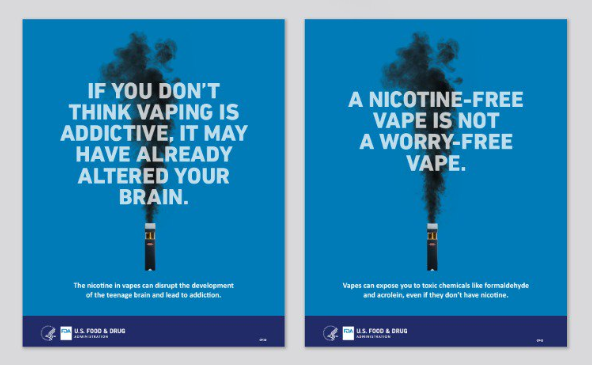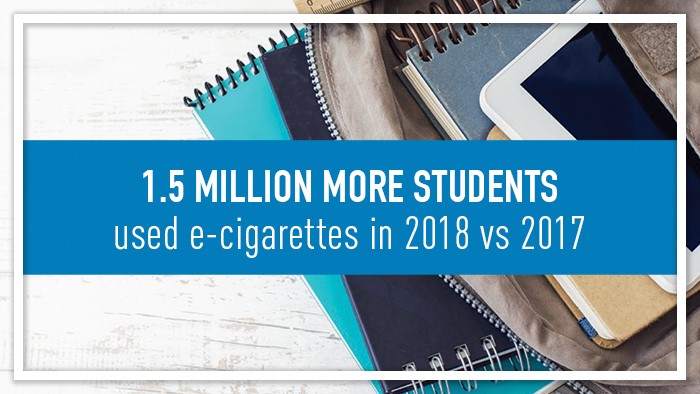Webpage
Think E-Cigs Can’t Harm Teens’ Health?
Preview Text for Your Web Page
The following text is a preview of content you can place on your website.
The science says they can. The nicotine in e-cigarettes can change the young brain and get kids hooked.

Are you aware that the nicotine in tobacco products such as e-cigarettes can rewire the teen brain to crave more of the substance and create a nicotine addiction?1 The types of brain changes that can occur may have long-lasting effects on attention, learning, and memory.2,3,4 Also, nicotine addiction can lead to regular use of tobacco products, resulting in long-term exposure to toxic chemicals. Because cigarettes aren’t the only tobacco product that can lead to addiction, FDA is doing what’s necessary to keep e-cigarettes and all other tobacco products out of minors’ hands. Here’s why…
By approximately age 11 for girls and 14 for boys, the brain is about as big as it’s going to get.5 But size aside, this organ at the center of sensation and intellect will continue to develop for years after that—into a person’s mid to late 20s.5 As a young person’s still-maturing brain swiftly builds “synapses” that act as bridges between brain cells, learning to play the piano or mastering a new technology can come more easily than in adulthood. Unfortunately, so can addiction.
FDA created a toolkit, Resources for Professionals About Vaping & E-Cigarettes, for adults and professionals who work with youth. This FREE resource provides fast facts about youth vaping and e-cigarettes.
Why Addiction Is Dangerous
Young people are more likely to take risks with their health, including the risk of using products that contain nicotine. And teens are especially susceptible to addiction to nicotine, whether the substance comes from a
cigarette, e-cigarette, or other tobacco product.6 Some e-cigarettes popular among kids, such as JUUL, deliver especially high levels of nicotine.

Addiction to nicotine matters because using nicotine as a teen may have enduring impacts on attention, learning, and memory,2,3,4 and addiction keeps people using harmful tobacco products. But research shows that many youth underestimate how addictive nicotine is, and have low risk perceptions of products like e-cigarettes.6,7
While studies are underway to further clarify the dangers associated with various tobacco products, science has already taught us some things about e-cigarettes—even those that are nicotine-free or promoted that way.
For example, did you know…?
E-cigarette aerosols can contain:
- The chemicals formaldehyde, acrolein, and acetaldehyde—also found in cigarette smoke—which can cause lung damage.8,9,10
- Toxic metal particles such as nickel, lead, and chromium, which can be inhaled into the lungs.11,12
- Additional toxic chemicals such as acrylonitrile, propylene oxide, and crotonaldehyde.13
E-Cig Upsurge and FDA’s Commitment
For the fifth year running, e-cigarettes have been the most commonly used tobacco product among U.S. middle and high school students, according to the 2018 National Youth Tobacco Survey (NYTS).14 And from 2017 to 2018, a troubling upsurge has been seen in youth use of e-cigarettes, with a 78 percent increase among high school students, and 48 percent among middle school students. The total number of middle and high school students currently using e-cigarettes rose to 3.6 million in 2018, which is 1.5 million more than in the previous year. The National Youth Tobacco Survey also found that youth who use e-cigarettes are using them—and flavored products—more frequently than they did the previous year.

Not only does e-cigarette use come with risks of its own, but research has also shown that youth who vape are more likely to start smoking combustible cigarettes,15 despite their well-known and often-deadly health consequences such as lung cancer and heart disease.
“We will take whatever action is necessary to stop youth e-cigarette use from continuing to build and to ensure young e-cigarette users don’t become future smokers,”
FDA Commissioner Scott Gottlieb said about the agency’s imperative to confront the youth e-cigarette epidemic.
FDA’s Steps to Stem the Epidemic
FDA is taking forceful steps to prevent kids from ever starting to use tobacco products. The agency launched its Comprehensive Plan for Tobacco and Nicotine Regulation in 2017, placing nicotine and the issue of addiction front-and-center because of the key role they play in leading to death and disease from tobacco use. Part of the tobacco regulatory plan, the Youth Tobacco Prevention Plan, focuses specifically on preventing youth access to tobacco products; curbing marketing of tobacco products aimed at youth; and educating teens about the dangers of using any tobacco product, as well as educating retailers about their key role in protecting youth.
No kids should be using any tobacco product, and federal law prohibits tobacco sales to those under 18. The agency has ramped up enforcement efforts related to e-cigarette marketing and sales, and in November 2018, the concerning findings from the 2018 NYTS youth e-cigarette use data prompted FDA to outline a policy framework focused on addressing youth appeal of, and access to, flavored tobacco products, which appear to be at the heart of the youth tobacco use problem. FDA also held a public hearing recently that included discussion of the potential role of drug therapies to support youth e-cigarette cessation and issues related to development of such therapies.
Meanwhile, FDA invests heavily in research to continue to build the science base related to tobacco products, as well as in science-based campaigns to educate youth about their dangers. In September 2018, FDA expanded “The Real Cost” education effort to focus on youth e-cigarette prevention. “The campaign aims to challenge teens’ cost-free mentality, with messages about the risks of using e-cigarettes, including nicotine’s impact on the developing brain and potential exposure to harmful chemicals,” FDA Center for Tobacco Products director Mitchell Zeller, J.D., wrote in a recent American Journal of Preventive Medicine issue dedicated to “The Real Cost.”
Play a Part Along with FDA
CTP is committed to protecting Americans—and especiallly our country’s youth—from the dangers of tobacco and nicotine. And the public can help FDA enforce the law by reporting possible violations, such as the sale of tobacco products to minors or the sale of cigarettes in packages of less than 20. While FDA applies its regulatory authority toward preventing current and future generations of kids from starting down a path of lifelong addiction, teens should bear in mind that the choice made in youth to use any tobacco product can train the brain to yearn for more nicotine, setting the stage for potentially devastating health consequences down the road.
LEARN MORE…
Find additional online information from FDA about federal tobacco law and the agency’s actions and announcements related to youth and tobacco:
- Youth and Tobacco Webpage
- 2018 National Youth Tobacco Survey
- Comprehensive Plan for Tobacco and Nicotine Regulation
- Youth Tobacco Prevention Plan
- CTP Compliance and Enforcement
Find additional educational resources from FDA:
- Nicotine: The Addictive Chemical in Tobacco Products: Learn myths and facts
- E-Cigarette Prevention Posters and Other Print Materials: Order from the FDA Tobacco Education Resource Library.
- “This Is Our Watch”: Information to help tobacco retailers comply with the law
- CTP Tobacco Compliance Webinars: Information about federal tobacco regulations that retailers and small manufacturers may find especially helpful


